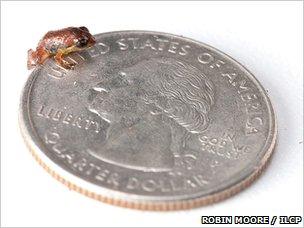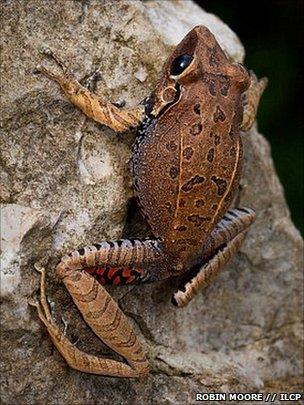Frogs survive on Haiti's bare hillsides
- Published

The Macaya breast-spot frog is one of the world's smallest amphibian species - especially the young
A conservation expedition to the deforested hills of Haiti, struck by a major earthquake a year ago, has found frog species unseen for 20 years.
In just eight days of searching in the few forest fragments left, researchers found 25 of Haiti's 49 known species.
They hope this will focus attention on conserving the few percent that remain of the nation's once abundant forest.
The 12 January 2010 earthquake killed an estimated 230,000 people and left about 1.2 million homeless.
Haiti is one of the poorest countries in the world, with much of its population eking out a subsistence living on farming and charcoal-making.
Poverty was one of the reasons cited in the quake's aftermath for why it had such a huge impact.
Even before the upheaval, conservation was in a dire state with so much of the country's natural habitat having been cleared away.
There were concerns that people moving away from the stricken coastal zone would increase pressure on the few remaining pieces of forest.
But this appears not have been the case - at least in the forests of the Massif de la Hotte and Massif de la Selle.
"Within Haiti, very few people have been to this area, which is one of the reasons we wanted to do this - to highlight what is still there," said Robin Moore of Conservation International, who led the expedition.
"If we talk to people in [the capital] Port-au-Prince about conservation, they shake their heads and ask 'what are we going to conserve?' - but we showed that there is good forest still, and it contains some unique species."
The expedition was not a complete success, with no sightings of the principal target - the La Selle grass frog, which was last seen 25 years ago and is listed as possibly extinct.
But among the species that were seen were five that were last recorded in 1991.
They include the Hispaniolan ventriloquial frog, named because of its call.
Consisting of a rapid seven-note sequence of chirps, the animal appears to project its voice into the forest.

The Macaya burrowing frog is one of several clinging on in the Massif de la Hotte
Mozart's frog also aquired its name from its call, a whistling sound that emerges at dawn and dusk.
And the Macaya breast-spotted frog is one of the world's smallest, with adults about the size of a grape.
However, the intent of the conservationists involved is not merely to protect the amphibians.
"Haiti's problems didn't start with the earthquake - it was pretty desperate before, and a lot of the country's problems stem from environmental degradation," Dr Moore told BBC News.
"So I think we need to get that on the agenda and do things better; and I think we can offer a better quality of life through investing in sustainable practices such as shade-grown coffee and things that conserve the environment.
"Right now, a lot of people are growing cash crops and the soil degrades, and they have to eat into the few remaining bits of forest - and that can only go on for some time before you cut down the last tree.
"So we're using the frogs to highlight what they still have; but ultimately it's the forest we're interested in preserving, because if they don't save that, they've got nothing to grow from."
The expedition to Haiti in October was run by Conservation International and the Amphibian Specialist Group of the International Union for the Conservation of Nature (IUCN).
It was an adjunct to a larger project aiming to rediscover amphibian species thought to be extinct - a project that has already turned up a Mexican salamander not seen since its discovery in 1941, a frog from the Ivory Coast last observed in 1967, and another frog from Democratic Republic of Congo not seen since 1979.
- Published8 January 2011
- Published16 November 2010
- Published26 October 2010
- Published30 April 2010